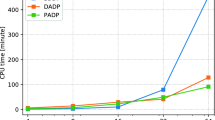Abstract
We consider an energy production network with zones of production and transfer links. Each zone representing an energy market (a country, part of a country or a set of countries) has to satisfy the local demand using its hydro and thermal units and possibly importing and exporting using links connecting the zones. Assuming that we have the appropriate tools to solve a single zonal problem (approximate dynamic programming, dual dynamic programming, etc.), the proposed algorithm allows us to coordinate the productions of all zones. We propose two reformulations of the dynamic model which lead to different decomposition strategies. Both algorithms are adaptations of known monotone operator splitting methods, namely the alternating direction method of multipliers and the proximal decomposition algorithm which have been proved to be useful to solve convex separable optimization problems. Both algorithms present similar performance in theory but our numerical experimentation on real-size dynamic models have shown that proximal decomposition is better suited to the coordination of the zonal subproblems, becoming a natural choice to solve the dynamic optimization of the European electricity market.











Similar content being viewed by others
References
Bauschke HH, Combettes PL (2011) Convex analysis and monotone operator theory in Hilbert spaces. Springer, Berlin
Bertsekas DP (2000) Dynamic programming and optimal control, vol 1–2, 2nd edn. Athena Scientific, Belmont, MA
Boyd S, Parikh N, Chu E, Peleato B, Eckstein J (2011) Distributed optimization and statistical learning with the alternating direction method of multipliers. Found Trends Mach Learn 3:1–122
Combettes PL, Pesquet JC (2011) Proximal splitting methods in signal processing. In: Bauschke HH, Burachik RS, Combettes PL, Elser V, Luke DR, Wolkowicz H (eds) Fixed-point algorithms for inverse problems in science and engineering. Springer, Berlin, pp 185–212
Dallagi A, Lenoir A (2013) A stochastic zonal decomposition algorithm for network energy management problems. Research Report, EDF
Eckstein J, Bertsekas DP (1992) On the douglas-rachford splitting method and the proximal point algorithm for maximal monotone operators. Math Program 55:293–318
Fortin M, Glowinski R (1983) Augmented Lagrangian methods: application to the numerical solution of boundary-value problems. North-Holland, Amsterdam
Fukushima M (1992) Application of the alternating direction method of multipliers to separable convex programming. Comput Optim Appl 1:93–112
Gabay D (1983) Applications of the method of multipliers to variational inequalities. Studies in mathematics and its applications, vol 15
Glowinski R, Le Tallec P (1989) Augmented Lagrangian and operator-splitting methods in nonlinear mechanics. SIAM, Philadelphia
Koko J (2011) Uzawa block relaxation for the unilateral contact problem. J Comput Appl Math 235:2343–2356
Koko J, Jehan-Besson S (2010) An augmented lagrangian method for \({TV}_g\)+\({L}^1\)-norm minimization. J Math Imag Vis 38:182–196
Lenoir A, Mahey P (2017) Monotone operator splitting methods and decomposition of convex programs. RAIRO 51:17–41
Lions PL, Mercier B (1979) Splitting algorithms for the sum of two nonlinear operators. SIAM J Numer Anal 16:964–979
Mahey P, Oualibouch S, Pham DT (1995) Proximal decomposition on the graph of a maximal monotone operator. SIAM J Optim 5:454–466
Ouorou A, Mahey P, Vial JP (2000) A survey of algorithms for convex multicommodity flow problems. Manag Sci 46:126–147
Pereira MVF, Pinto LMVG (1991) Multistage stochastic optimization applied to energy planning. Math Program 52:359–375
Rockafellar RT, Wets RJ-B (1991) Scenarios and policy aggregation in optimization under uncertainty. Math Oper Res 16:119–147
Spingarn JE (1985) Applications of the method of partial inverses to convex programming:decomposition. Math Program 32:199–223
Acknowledgements
The authors acknowledge the financial support of PGMO program (Programme Gaspard Monge pour l’Optimisation). The authors are very grateful to the anonymous referees for their helpful and valuable suggestions and remarks, which greatly improved the earlier version of this paper.
Author information
Authors and Affiliations
Corresponding author
Rights and permissions
About this article
Cite this article
Mahey, P., Koko, J. & Lenoir, A. Decomposition methods for a spatial model for long-term energy pricing problem. Math Meth Oper Res 85, 137–153 (2017). https://doi.org/10.1007/s00186-017-0573-5
Received:
Accepted:
Published:
Issue Date:
DOI: https://doi.org/10.1007/s00186-017-0573-5
Keywords
- Alternating direction method of multipliers
- Operator splitting
- Dynamic programming
- Production planning
- Proximal decomposition




